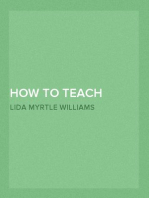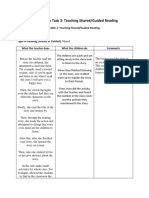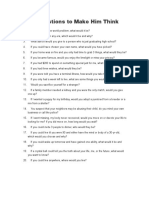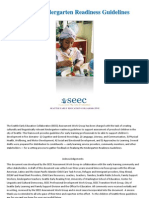Task 2
Uploaded by
api-307396733Task 2
Uploaded by
api-307396733Observation Task 2: Reading a Story in the local
UAE School
Identify the type of pre-whilst and post reading activities employed by your
MST
Table 7: Reading a Story in the local UAE Preschool
What the MST What the Comments
Does Children Do
(Weather report)
Pre-Reading - Listen and
Activities The teacher play the sing the
Name the book / story. weather song, then song.
Describe how your let the children - Answer the
MST gets children predict what the teacher
interested in the story
and wanting to hear / story will be about questions.
read it. by looking at the
cover page, title.
The teacher ask the - Listen The teacher
children about what carefully. voice level
will happens next, to was the
keep them actively - Answer the same, she
While-Reading involve. Use facial teacher have to
Activities expirations and body questions. focus more
How your MST keeps
children interested and language to keep the about
actively involved. children interested. chancing
the tone,
pitch.
Because
the children
get bored.
The teacher repeats The children repeat
the target language, the target
Post-Reading
such as sunny, language after the
Activities
How your MST windy, cloudy, and teacher.
consolidates the rainy.
storyline and explores
The children will
opportunities for
developing language, Let the children express their
topic related and express and tell any thoughts, personal
personal, social and
personal stories, by stories.
emotional issues.
say it or draw it.
which related to the
topic.
Reflections on Observation Task 2: Reading a Story in the
Local UAE Preschool
1. What preparation (i.e. pre-listening activity) did the teacher
give the learners before they listened to the text? First she
revise with the children about the sound, phonics then she
played a song about the story that they will listen to, to let the
children predict what the story will be about, then looking at
the cover page, title of the story.
If they had some preparation, select (a) if they did not, select (b).
a. How did the pre-listening activity help students understand?
Understand the meaning of the weather, target words. Understand the four
seasons in general.
b. What pre-listening activity could the teacher have used to help
students understand the target language better?
2. Were the learners engaged in while-listening activity/activities? If they
were, select (a); if they were not, select (b).
a. What were the aims of the while-listening activity/activities?
Give them a clue, idea about the story, knows the target words from the song.
b. What while-listening activity/activities could the teacher have used
to help learners understand better what they were listening to?
3. Did the learners have a post-listening activity/activities? If they
did, select (a); if they did not, select (b).
a. What were the aims of the post-listening activity/activities?
Knows the target words, how each season looks like.
b. What post-listening activity/ activities might have helped the learners to
understand what they had heard well?
4. How many times did the learners listen to the text / recording? twice
a. Would it have increased their understanding if they had been allowed to
listen to the recording again? Explain. Yes, I think it will increase their
understanding of the words, meaning and the whole picture. Because they
will be able to listen to the target words, sounds once again, because
children will not learn easily as adult. They must repeat to learn.
b. Did the learners hear the whole text at once, or in parts? Parts
c. If so, which was the most helpful? I think in parts, because for children you must
pause and ask questions, opinions and describe the text, picture. So, the children
can get the idea easily.
Think about the advantages and disadvantages of using the model of
pre-, while- and post-listening activities to teach a listening lesson.
Write first from the perspective of the teacher and then from the
perspective of the learners.
Advantage for teacher: makes her job easy.
Disadvantage for teacher: Makes her plan for more than one activity.
Advantage for learners: Makes them understand easily.
Disadvantage for learners: Makes them board maybe.
You might also like
- The Hidden Truth of Wealth - Oliver Mercer100% (10)The Hidden Truth of Wealth - Oliver Mercer46 pages
- Rachel Reid - (Game Changers 02) - Heated Rivalry PDF71% (24)Rachel Reid - (Game Changers 02) - Heated Rivalry PDF300 pages
- The Empath's Survival Guide - Life Strategies For Sensitive People (PDFDrive) PDF83% (12)The Empath's Survival Guide - Life Strategies For Sensitive People (PDFDrive) PDF254 pages
- The 36 Questions That Lead To Love - The New York Times94% (34)The 36 Questions That Lead To Love - The New York Times3 pages
- Big Book of ACT Metaphors, The - Hayes, Steven C., Stoddard, Jill A., Afari, Niloofar PDF97% (61)Big Book of ACT Metaphors, The - Hayes, Steven C., Stoddard, Jill A., Afari, Niloofar PDF250 pages
- The 36 Questions That Lead To Love - The New York Times95% (21)The 36 Questions That Lead To Love - The New York Times3 pages
- "How To Win Friends and Influence People" Cheat Sheet96% (25)"How To Win Friends and Influence People" Cheat Sheet2 pages
- Handbook To Higher Consciousness Ken Keyes JR100% (46)Handbook To Higher Consciousness Ken Keyes JR180 pages
- Building Better Habits With The Habit Loop: 1. CUE 2. Craving91% (64)Building Better Habits With The Habit Loop: 1. CUE 2. Craving1 page
- The ONE Thing - The Surprisingly Simple Truth Behind Extraordinary Results (PDFDrive)100% (56)The ONE Thing - The Surprisingly Simple Truth Behind Extraordinary Results (PDFDrive)214 pages
- Educational Research Chapter 1 Introduction To Educational Research Gay, Mills, and Airasian100% (2)Educational Research Chapter 1 Introduction To Educational Research Gay, Mills, and Airasian41 pages
- Barriers To Effective Verbal CommunicationNo ratings yetBarriers To Effective Verbal Communication2 pages
- Observation Task 2: Reading A Story in The Local UAE SchoolNo ratings yetObservation Task 2: Reading A Story in The Local UAE School3 pages
- Reflections On Observation Task 2: Reading A Story in The Local UAE PreschoolNo ratings yetReflections On Observation Task 2: Reading A Story in The Local UAE Preschool1 page
- Observation Table: For Task 2 Teaching Listening: Section: Number of Learners: DateNo ratings yetObservation Table: For Task 2 Teaching Listening: Section: Number of Learners: Date6 pages
- Begin The Sentence With A Capital Letter and End The Sentence With A Full Stop. Use A Finger Space Between WordsNo ratings yetBegin The Sentence With A Capital Letter and End The Sentence With A Full Stop. Use A Finger Space Between Words6 pages
- Observation Task 3: Teaching Shared/Guided ReadingNo ratings yetObservation Task 3: Teaching Shared/Guided Reading3 pages
- Lesson Plan: Lesson Self-Introduction AimNo ratings yetLesson Plan: Lesson Self-Introduction Aim2 pages
- Saint Mary-of-the-Woods College Education DepartmentNo ratings yetSaint Mary-of-the-Woods College Education Department10 pages
- Assessment 2 Story Sack: (Teacher Amna's Trip)No ratings yetAssessment 2 Story Sack: (Teacher Amna's Trip)17 pages
- Scaffolding Children's Learning Through Story and Drama by Carol Read100% (1)Scaffolding Children's Learning Through Story and Drama by Carol Read4 pages
- Reductionism and Nominalism in DescartesNo ratings yetReductionism and Nominalism in Descartes12 pages
- Obr. MASLIN, K. T. An Introduction To The Philosophy of Mind PDFNo ratings yetObr. MASLIN, K. T. An Introduction To The Philosophy of Mind PDF175 pages
- Characteristics of Contemporary Theoretical Approaches in Leadership ResearchNo ratings yetCharacteristics of Contemporary Theoretical Approaches in Leadership Research5 pages
- Extended Response Question Template: Question: Evaluate Schema Theory With Reference To Research StudiesNo ratings yetExtended Response Question Template: Question: Evaluate Schema Theory With Reference To Research Studies5 pages
- Teaching Vocabulary Through Games To Elementary Students - Chapter 2100% (1)Teaching Vocabulary Through Games To Elementary Students - Chapter 212 pages
- Teacher Working Conditions That Matter - Evidence For ChangeNo ratings yetTeacher Working Conditions That Matter - Evidence For Change125 pages
- Multi-Criteria Decision-Making Selection Model With Application To Chemical Engineering Management DecisionsNo ratings yetMulti-Criteria Decision-Making Selection Model With Application To Chemical Engineering Management Decisions6 pages
- Rachel Reid - (Game Changers 02) - Heated Rivalry PDFRachel Reid - (Game Changers 02) - Heated Rivalry PDF
- The Empath's Survival Guide - Life Strategies For Sensitive People (PDFDrive) PDFThe Empath's Survival Guide - Life Strategies For Sensitive People (PDFDrive) PDF
- The 36 Questions That Lead To Love - The New York TimesThe 36 Questions That Lead To Love - The New York Times
- Big Book of ACT Metaphors, The - Hayes, Steven C., Stoddard, Jill A., Afari, Niloofar PDFBig Book of ACT Metaphors, The - Hayes, Steven C., Stoddard, Jill A., Afari, Niloofar PDF
- The 36 Questions That Lead To Love - The New York TimesThe 36 Questions That Lead To Love - The New York Times
- "How To Win Friends and Influence People" Cheat Sheet"How To Win Friends and Influence People" Cheat Sheet
- Building Better Habits With The Habit Loop: 1. CUE 2. CravingBuilding Better Habits With The Habit Loop: 1. CUE 2. Craving
- The ONE Thing - The Surprisingly Simple Truth Behind Extraordinary Results (PDFDrive)The ONE Thing - The Surprisingly Simple Truth Behind Extraordinary Results (PDFDrive)
- Educational Research Chapter 1 Introduction To Educational Research Gay, Mills, and AirasianEducational Research Chapter 1 Introduction To Educational Research Gay, Mills, and Airasian
- Observation Task 2: Reading A Story in The Local UAE SchoolObservation Task 2: Reading A Story in The Local UAE School
- Reflections On Observation Task 2: Reading A Story in The Local UAE PreschoolReflections On Observation Task 2: Reading A Story in The Local UAE Preschool
- Observation Table: For Task 2 Teaching Listening: Section: Number of Learners: DateObservation Table: For Task 2 Teaching Listening: Section: Number of Learners: Date
- Begin The Sentence With A Capital Letter and End The Sentence With A Full Stop. Use A Finger Space Between WordsBegin The Sentence With A Capital Letter and End The Sentence With A Full Stop. Use A Finger Space Between Words
- Observation Task 3: Teaching Shared/Guided ReadingObservation Task 3: Teaching Shared/Guided Reading
- Saint Mary-of-the-Woods College Education DepartmentSaint Mary-of-the-Woods College Education Department
- Scaffolding Children's Learning Through Story and Drama by Carol ReadScaffolding Children's Learning Through Story and Drama by Carol Read
- Obr. MASLIN, K. T. An Introduction To The Philosophy of Mind PDFObr. MASLIN, K. T. An Introduction To The Philosophy of Mind PDF
- Characteristics of Contemporary Theoretical Approaches in Leadership ResearchCharacteristics of Contemporary Theoretical Approaches in Leadership Research
- Extended Response Question Template: Question: Evaluate Schema Theory With Reference To Research StudiesExtended Response Question Template: Question: Evaluate Schema Theory With Reference To Research Studies
- Teaching Vocabulary Through Games To Elementary Students - Chapter 2Teaching Vocabulary Through Games To Elementary Students - Chapter 2
- Teacher Working Conditions That Matter - Evidence For ChangeTeacher Working Conditions That Matter - Evidence For Change
- Multi-Criteria Decision-Making Selection Model With Application To Chemical Engineering Management DecisionsMulti-Criteria Decision-Making Selection Model With Application To Chemical Engineering Management Decisions























































































































